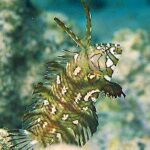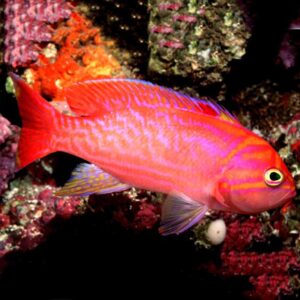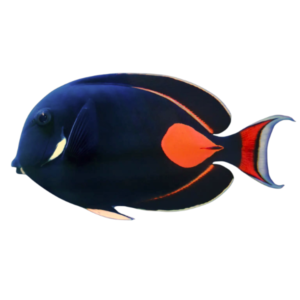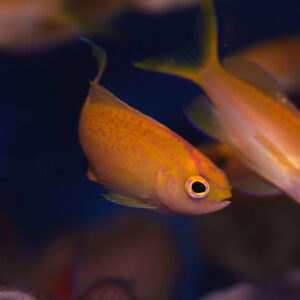Description
Red Breasted Maori Wrasse, Cheilinus fasciatus, also go by the name Banded Maori. As the names suggests, these fascinating fish display prominent black and white bands. As juveniles, their heads are green. When mature they develop the bold red patch, which extends from behind the eye to past the pectoral fin. These fish do not appear very often in the trade. Although they are ideal for adding a colour and activity in a predator tank.
Red Breasted Maori Wrasse, Cheilinus fasciatus, Ecology:
These fish live in the Indian and West Pacific Ocean. They range from: East Africa, Japan, Australia, Samoa, Micronesia and Ryukyu Islands. Red breasts live in mixed habitats. They can be found in sandy and rocky areas, as well as around rubble or on coral reefs. Adults appear on seaward reefs or in lagoons mostly, while juveniles occur in more protected areas.
These fish do not appear in groups, instead they form distinct pairs when breeding. Visibly, there is no real difference between males and females. Although, the larger males can sometimes have a more pronounced lower jaw. Red Breasted Maori Wrasse are protogynous hermaphrodites. Which means that, when they get old enough, breeding females transition into a male.
These fish have extensive diets. They are able to crack through mollusc and echinoderms, as well as ambush shrimp and fish. Buried prey items are also in reach of the predator. Red Breasted Maori Wrasse will jet water on sand beds to find a hiding fish or crab.
Banded Maori in the Aquarium:
It is important to imitate the natural environment by providing plenty of nooks and crannies for the fish to investigate. Hobbyists should invest in a jump guard to prevent any unfortunate mishaps.
Red Breasted Maori Wrasse do best when fed a varied diet. They will accept frozen krill and whole frozen fish, that we enrich with garlic and vitamins. These additives are extremely useful for supporting fish immune systems. They will also devour live foods, such as feeder shrimp, or graze on nori. Over time, they will accept high-quality pellet or flake. We adapt all our wrasse to aquarium life before they leave us. We focus on their health, and most are eating a good quality flake food and/or pellet, such as JBL Maris, before being offered for sale.
The Fish pictured here are representative only and the livestock you receive may vary in pattern, coloration, and shape.









 API Stress Coat + 32oz ( pond version )
API Stress Coat + 32oz ( pond version )